| Lesson 6 | Developing P/SQL Applications for Enqueuing |
| Objective | Set up enqueuing to the Advanced Queue |
Developing PL/SQL Applications for Enqueuing
Now that you have a queue set up, you can create PL/SQL code to enqueue a message to the queue.
You use each of the variables you declared at the start of the procedure. Because you will not be changing any of the options for enqueuing the message or for the message itself, you do not have to set any values for the
- Enqueuing Message in Oracle
To enqueue a message, you will have to use the following PL/SQL code in a procedure. This procedure will be in a PL/SQL package calledPETSTORE.AQ_EX. The procedure itself will be calledAQ_ENQ, and it will take an incoming parameter of data typeVARCHAR2(100)calledMSG_TEXT. This incoming parameter will pass the message text to the message payload.
The body of the PL/SQL package includes the following code:
DECLARE Enqueue_options DBMS_AQ.enqueue_options_t; Message_properties DBMS_AQ.message_properties_t; Message_handle RAW(16); Message PETSTORE.Message_typ;
- You need to declare four variables necessary to enqueue a message:
-
Enqueue_options: Allows you to set various options for enqueuing the message. You use the data typeenqueue_options_t, which is defined in theDBMS_AQpackage. Message_properties: Allows you to set various options for the message itself. You use the data typemessage_properties_t, which is defined in theDBMS_AQpackage.Message_handle:Will accept a value assigned by the Advanced Queuing process.Message:The message payload you created when you created the queue.
- The next step is to start the procedural code by assigning the value of the
MSG_TEXTparameter to the message payload:
BEGIN Message := Message_typ("This is a sample message);
- The final step in enqueuing a message is to call the
ENQUEUEprocedure from theDBMS_AQpackage and end the procedural code:
DBMS_AQ.ENQUEUE(queue_name => 'queue1', enqueue_options => enqueue_options, message_properties => message_properties, payload => message, msgid => message_handle); COMMIT; END;
You use each of the variables you declared at the start of the procedure. Because you will not be changing any of the options for enqueuing the message or for the message itself, you do not have to set any values for the
enqueue_options or message_properties variables. The enqueuing process described above is illustrated in the following series of images.
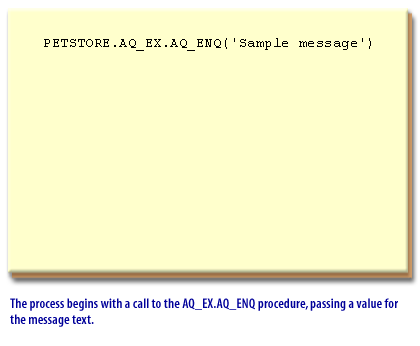
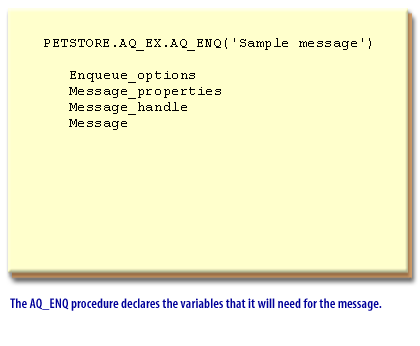
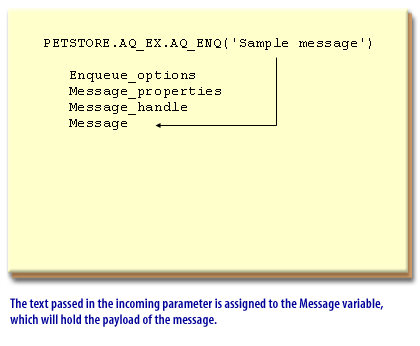
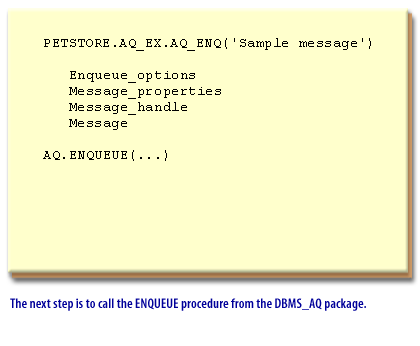
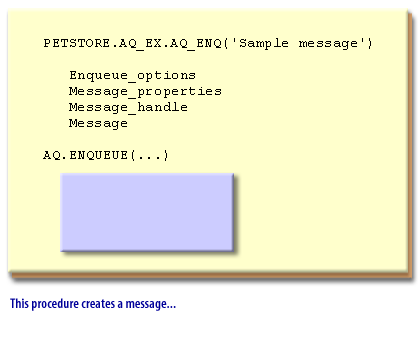
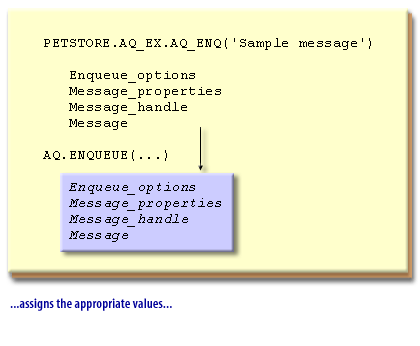
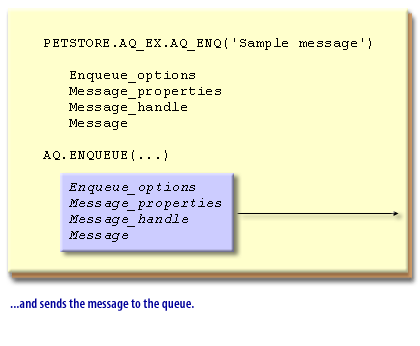
Creating a Queue Table and Queue of Object Type
/* Creating a message type: */ CREATE type aq.Message_typ as object ( subject VARCHAR2(30), text VARCHAR2(80));
/* Creating a object type queue table and queue: */ EXECUTE DBMS_AQADM.CREATE_QUEUE_TABLE ( queue_table => 'aq.objmsgs80_qtab', queue_payload_type => 'aq.Message_typ'); EXECUTE DBMS_AQADM.CREATE_QUEUE ( queue_name => 'msg_queue', queue_table => 'aq.objmsgs80_qtab'); EXECUTE DBMS_AQADM.START_QUEUE ( queue_name => 'msg_queue');
Creating a Queue Table and Queue of Raw Type
/* Creating a RAW type queue table and queue: */ EXECUTE DBMS_AQADM.CREATE_QUEUE_TABLE ( queue_table => 'aq.RawMsgs_qtab', queue_payload_type => 'RAW'); EXECUTE DBMS_AQADM.CREATE_QUEUE ( queue_name => 'raw_msg_queue', queue_table => 'aq.RawMsgs_qtab'); EXECUTE DBMS_AQADM.START_QUEUE ( queue_name => 'raw_msg_queue');
Creating Prioritized Message Queue Table and Queue
EXECUTE DBMS_AQADM.CREATE_QUEUE_TABLE ( queue_table => 'aq.priority_msg', sort_list => 'PRIORITY,ENQ_TIME', queue_payload_type => 'aq.Message_typ'); EXECUTE DBMS_AQADM.CREATE_QUEUE ( queue_name => 'priority_msg_queue', queue_table => 'aq.priority_msg'); EXECUTE DBMS_AQADM.START_QUEUE ( queue_name => 'priority_msg_queue');
Creating a Multiconsumer Queue Table and Queue
EXECUTE DBMS_AQADM.CREATE_QUEUE_TABLE ( queue_table => 'aq.MultiConsumerMsgs_qtab', multiple_consumers => TRUE, queue_payload_type => 'aq.Message_typ');
EXECUTE DBMS_AQADM.CREATE_QUEUE ( queue_name => 'msg_queue_multiple', queue_table => 'aq.MultiConsumerMsgs_qtab'); EXECUTE DBMS_AQADM.START_QUEUE ( queue_name => 'msg_queue_multiple');
Creating a Queue to Demonstrate Propagation
EXECUTE DBMS_AQADM.CREATE_QUEUE ( queue_name => 'another_msg_queue', queue_table => 'aq.MultiConsumerMsgs_qtab'); EXECUTE DBMS_AQADM.START_QUEUE ( queue_name => 'another_msg_queue');
In the next lesson, you will learn how to dequeue a message.